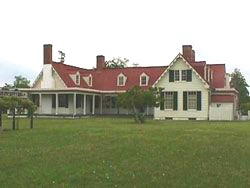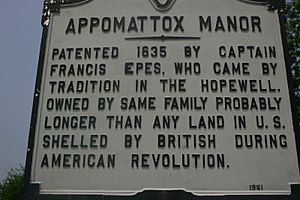Appomattox Manor facts for kids
|
Appomattox Manor
|
|
|
U.S. Historic district
Contributing property |
|

Appomattox Manor
|
|
| Location | Cedar Lane, at confluence of James and Appomattox Rivers, Hopewell, Virginia |
|---|---|
| Area | 10 acres (4.0 ha) |
| Built | 1751 |
| NRHP reference No. | 69000015 |
Quick facts for kids Significant dates |
|
| Added to NRHP | October 01, 1969 |
Appomattox Manor is a historic plantation house located in Hopewell, Virginia, United States. It is most famous for being the main headquarters for the Union Army during the Siege of Petersburg in 1864-1865.
The house was built around 1751. It sits on a bluff, which is a high cliff, overlooking where the James River and Appomattox River meet. Today, the National Park Service manages the house and its surrounding land. You can visit the Grant's Headquarters at City Point Museum there. This museum is part of the Petersburg National Battlefield Park.
Appomattox Manor: Before the Civil War
The Eppes family had lived in this home for about 100 years before Union forces arrived in 1864. The house was built on a large area of land that Captain Francis Eppes first got in 1635. By the time of the American Civil War, it was the center of a large farm called a plantation. This plantation covered more than 2,300 acres (about 9.3 square kilometers).
The War Years: A Busy Headquarters
In 1861, Dr. Richard Eppes owned Appomattox Plantation. He owned three plantations and many enslaved people who were forced to work there. Dr. Eppes was not strongly in favor of the Southern states leaving the Union, a process called secession. However, when Virginia joined the Southern states, he joined a local cavalry unit. He soon left the army to work as a surgeon at a Confederate hospital in Petersburg.
The Eppes family stayed at their home until 1862. But when Union gunboats appeared on the James River, they had to leave their home. They went to Petersburg for safety. Soon after, most of the enslaved people left with the Union forces. Two years later, when the war reached Petersburg, Mrs. Eppes and the children had to flee again. This time, they went to her mother's home in Philadelphia, Pennsylvania.
Appomattox Plantation became the offices for U.S. Quartermaster Rufus Ingalls and his team during the siege. City Point was a port on the James River. In the last years of the Civil War, the City Point Railroad was used from this port. It helped supply the Union forces during the Siege of Petersburg from 1864 to 1865. Capturing Petersburg and its many railroad lines was very important. It led to the fall of the Confederate capital city of Richmond, which ended the war less than a week later.
After the war ended, Dr. Eppes returned home. He found his house almost ruined and his plantation nearly destroyed. It wasn't until March 1866, after the last Union soldiers left and the property was back in his name, that his wife and children returned home. They then began the hard work of rebuilding their lives.
Appomattox Manor was added to the National Register of Historic Places in 1969. The Eppes family later gave the manor house and the land around it to the National Park Service. It is located within the City Point Historic District.




